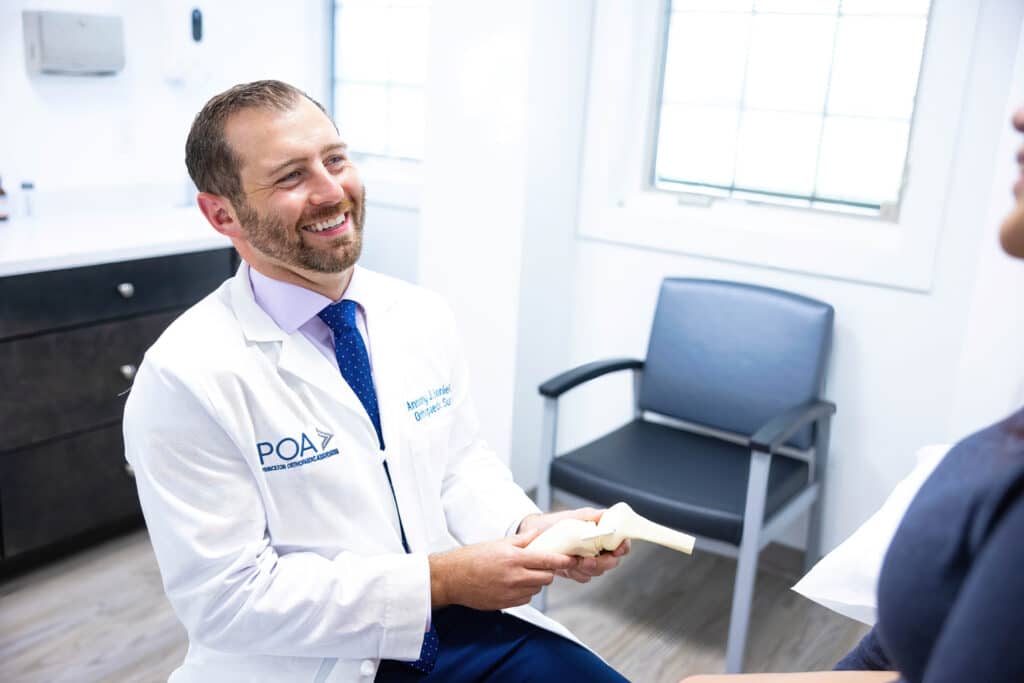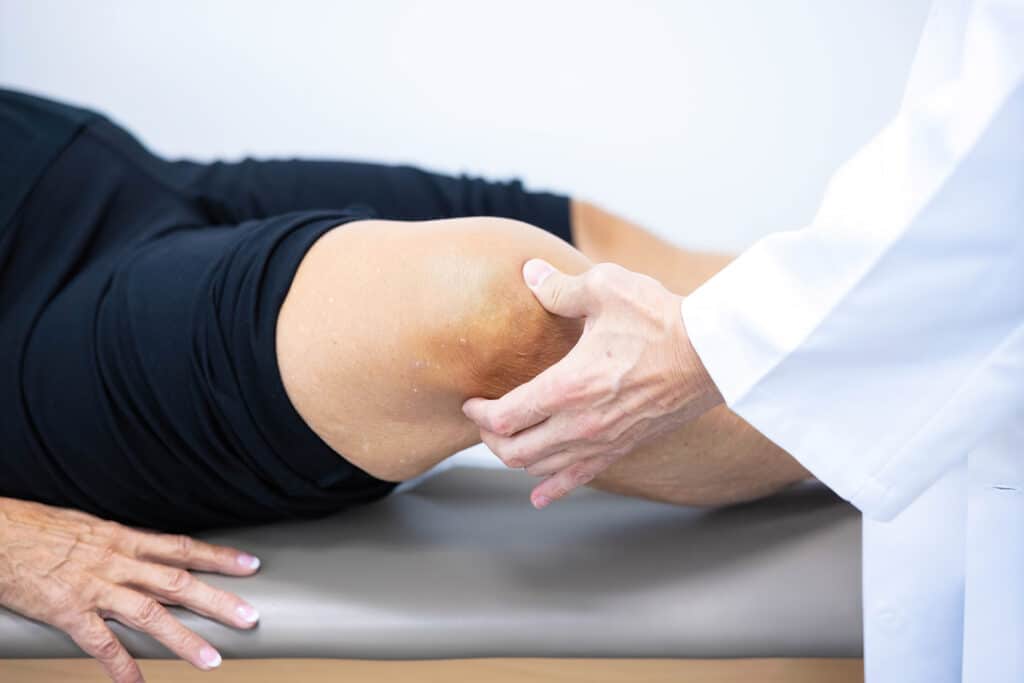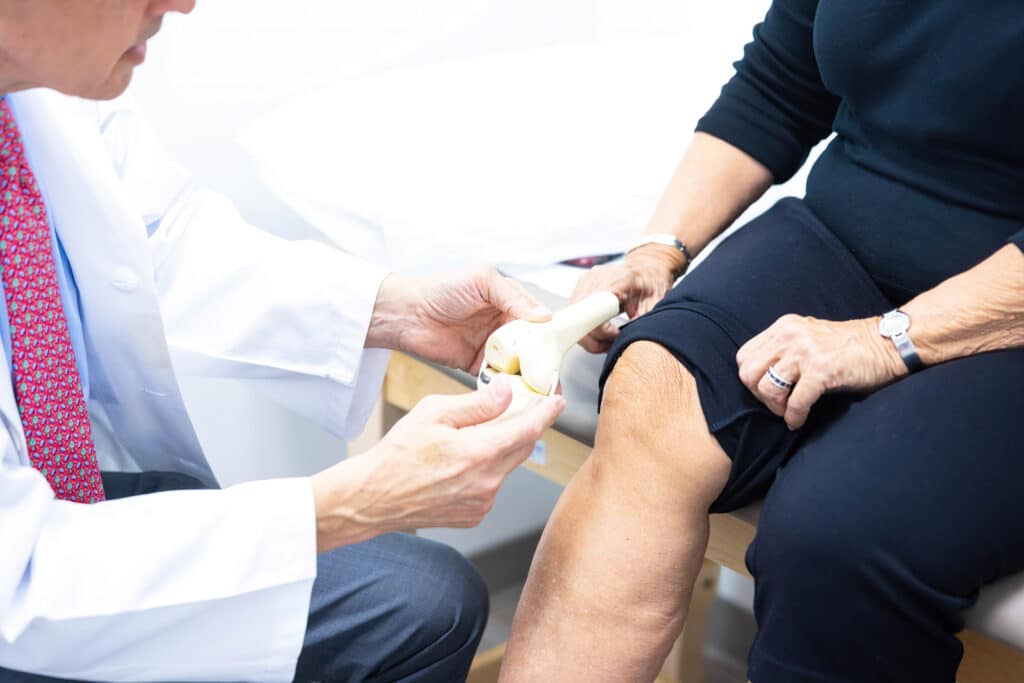
Physician Assistants
Physical & Occupational Therapists
KneeMRI ScansNon-OperativePhysiatry
Physical Therapy
Podiatry
Spine
Sports Medicine
TraumaUrgent Care
X-Ray Imaging

If you’re an athlete experiencing tenderness and discomfort around the front of your knee, chances are that you may be suffering from Patellofemoral Pain Syndrome (PFPS), more commonly referred to as “runner’s knee.” Although it often affects runners, it can also affect anyone -- especially those who participate in activities involving significant kneeling or squatting motions. Runner's knee is an overuse injury caused by repetitive strain on the patellar tendon located beneath the kneecap, resulting in irritation and damage to this tissue. Fortunately, there are a few things that you can do if you think you have runner's knee; recognizing and understanding its symptoms, having a professional diagnosis confirmed with radiologic imaging studies or X-rays, providing time for rest/healing of injured muscles/tissues along with physical therapy treatment plans including stretching exercises specific to PFPS injuries all serve as important factors towards alleviating pain symptoms. Taking preventive measures such as instituting proper form when running/exercising , wearing properly fitting footwear and ensuring gradual acclimation periods before increasing workout resistances will significantly reduce the risk for developing runner's knee further down the line.

Patellofemoral Pain Syndrome (PFPS), also known as runner's knee, is a common condition among runners and other athletes that occurs when the kneecap doesn't track properly over the femur. This can lead to pain and discomfort in the front of the knee during physical activity or even simple movements like walking up stairs. Common symptoms of runner's knee include a dull ache around the kneecap, a popping or grinding sensation when bending the knee, and swelling or tenderness around the knee joint. It's important to listen to your body and seek medical attention if you experience any of these symptoms, as PFPS can worsen over time and impact your ability to enjoy the activities you love.

Patellofemoral Pain Syndrome (PFPS) is a common condition that affects athletes, runners, and individuals who engage in activities requiring repetitive movements such as stair climbing, squatting, and kneeling. The symptoms of PFPS include pain in the front of the knee, discomfort while sitting, grinding or popping sounds while moving the knee, and difficulty in straightening the leg. Diagnosing PFPS can be done through a physical examination, imaging tests such as MRI or X-ray, and ruling out other knee conditions. Treatment options for PFPS include a combination of physical therapy, pain management, and lifestyle modifications. Physical therapy can help strengthen the muscles around the knee, while medications such as anti-inflammatory drugs can reduce the pain and swelling. Lifestyle modifications such as losing weight and avoiding high-impact activities that exacerbate the pain are also beneficial. Early diagnosis and prompt treatment of PFPS can help individuals return to their daily activities without pain and discomfort.

As an avid runner, there's nothing more frustrating than experiencing knee pain that can hinder your progress. Unfortunately, runner's knee is a common issue that many athletes face. This condition can be caused by a variety of factors such as overuse, muscle imbalances, or even poor footwear. However, the good news is there are ways to prevent this from happening. By keeping your muscles strong and flexible, maintaining proper form, and gradually increasing your mileage, you can reduce the risk of developing runner's knee. So don't let this issue hold you back from achieving your running goals - take care of your body and keep pounding the pavement.
If you suffer from knee pain or have had a knee injury, exercises to strengthen the muscles around your knee can make a big difference in your stability and overall comfort. There are many exercises that can help, including squats, lunges, leg presses, and leg curls. These exercises target the quadriceps, hamstrings, and glutes, all of which play a key role in supporting the knee joint. Additionally, exercises like wall sits and single-leg balance exercises can help improve your balance and stability, reducing the risk of future knee injuries. By incorporating these exercises into your workout routine, you can build stronger, more stable knees and enjoy a higher quality of life.
Runner's knee can be an annoying and painful occurrence. Whether you're a seasoned runner or just starting, trying to manage the pain of runner's knee can be a daunting task. However, with the right tools, you can overcome the pain and continue to pursue your fitness goals. Here are some tips for managing pain from runner's knee on a daily basis: (insert list here such as doing low-impact exercises, icing the affected area, taking over-the-counter pain medication, wearing proper shoes, stretching before and after exercise, and consulting with a healthcare professional). By implementing these tips into your daily routine, you'll be able to stay active and pain-free.
Patellofemoral pain syndrome (PFPS) is a common condition that affects the knee joint. It is characterized by pain around or under the patella (kneecap), especially during activities that involve bending of the knee. While many cases of PFPS can be treated with self-care measures, some cases require medical attention. You should seek medical help for PFPS if you experience persistent pain or swelling in your knee, or if you have difficulty performing daily activities. A specialist in orthopedics or sports medicine may be the right person to diagnose and treat your condition. They may perform a physical exam, imaging tests, or recommend medication, physical therapy, or surgery, depending on the severity of your condition. Don't ignore your knee pain; seek medical attention promptly and get back to your active lifestyle.
Ultimately, PFPS is a common and treatable condition that affects many runners. It is important to be aware of the symptoms, causes, and potential treatments to ensure runner's knee can be properly managed. By following the tips outlined in this article, you can take necessary steps to diagnose the condition early on and seek adequate treatment. Strengthening exercises are also beneficial for preventing and managing runner's knee. Additionally, paying attention to how certain activities or exercises affect your knee can help you identify when it’s time to rest as well as when to adjust your training plan. Since proper management is key for preventing more serious issues from occurring, seeking medical attention from a physiotherapist or sports medicine specialist if things don’t clear up with self care is always advised. With proper education and management of PFPS, runners can both successfully keep their knees healthy and pursue the activity that they love!

© 2023 Princeton Orthopaedic Associates. The contents of princetonorthopaedic.com are licensed under a Creative Commons Attribution-NonCommercial 4.0 International License. Copying without permission is strictly forbidden.